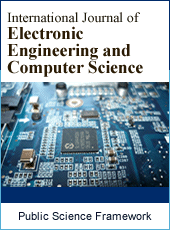International Journal of Electronic Engineering and Computer Science
Articles Information
International Journal of Electronic Engineering and Computer Science, Vol.4, No.1, Mar. 2019, Pub. Date: Apr. 29, 2019
Validation Methodologies for RAs: A Case Study of RAFAALS2.0
Pages: 1-9 Views: 2031 Downloads: 519
[01]
El Murabet Amina, Computer Engineering Department, National School of Applied Sciences of Tetuan, Tetuan, Morocco.
[02]
Abtoy Anouar, Computer Engineering Department, National School of Applied Sciences of Tetuan, Tetuan, Morocco.
[03]
Tahiri Abderahim, Computer Engineering Department, National School of Applied Sciences of Tetuan, Tetuan, Morocco.
To affirm the completeness, the success and the validation of RAs (Reference Architectures), a chain of validation process should be taking into account in the end of each assessment. The need behind the validation reveals from the necessity of achieving accuracy between the different components of the system, as well as, achieving a high level of abstraction. In the result of achieving a unique version of the suggested architecture to be considered as a reference for multiple projects. The existing methodologies, which allow driving the process of validation, are rare and incomplete. In this paper, we present three different approaches. Each one of them is described and applied into the case study, with the objective of extracting the loopholes to value the strength of each methodology. Finally, we investigate the results and draw the feedback to be used in the enhancement and development of new validating approaches related to RAs in software engineering.
Reference Architecture, Validation Methodologies, Software Engineering
[01]
P. B. Hongyu, “A Survey and Analysis of Reference Architectures for the Internet-of-things,” presented at the The Twelfth International Conference on Software Engineering Advances, Västerås, Sweden, 2017.
[02]
S. Martínez-Fernández, C. P. Ayala, X. Franch, and H. M. Marques, “Benefits and drawbacks of software reference architectures: A case study,” Information and Software Technology, vol. 88, pp. 37–52, Aug. 2017.
[03]
E. Y. Nakagawa, M. Guessi, J. C. Maldonado, D. Feitosa, and F. Oquendo, “Consolidating a Process for the Design, Representation, and Evaluation of Reference Architectures,” in 2014 IEEE/IFIP Conference on Software Architecture, 2014, pp. 143–152.
[04]
P. O. Antonino, D. Schneider, C. Hofmann, and E. Y. Nakagawa, “Evaluation of AAL Platforms According to Architecture-Based Quality Attributes,” in Ambient Intelligence, Springer, Berlin, Heidelberg, 2011, pp. 264–274.
[05]
A. El murabet, A. Abtoy, and A. Tahiri, “A Context-aware Reference Architecture for Ambient Assisted Living Information Systems,” MECS press, vol. 11, no. 2, pp. 9–20, Feb. 2019.
[06]
N. Kumar, “Software Architecture Validation Methods, Tools Support and Case Studies,” in Emerging Research in Computing, Information, Communication and Applications, Springer, 2016, pp. 335–345.
[07]
J. Magee, J. Kramer, and D. Giannakopoulou, “Behaviour analysis of software architectures,” in Software Architecture, Springer, 1999, pp. 35–49.
[08]
B. Graaf, H. van Dijk, and A. van Deursen, “Evaluating an Embedded Software Reference Architecture,” in Ninth European Conference on Software Maintenance and Reengineering, 2005, pp. 354–363.
[09]
A. Holzinger, G. Searle, A. Auinger, and M. Ziefle, “Informatics as Semiotics Engineering: Lessons Learned from Design, Development and Evaluation of Ambient Assisted Living Applications for Elderly People,” in Universal Access in Human-Computer Interaction. Context Diversity, 2011, pp. 183–192.
[10]
A. Caracciolo, M. F. Lungu, and O. Nierstrasz, “How do software architects specify and validate quality requirements?,” presented at the European Conference on Software Architecture, 2014, pp. 374–389.
[11]
R. Allen and D. Garlan, “A Formal Basis for Architectural Connection,” ACM Trans. Softw. Eng. Methodol., vol. 6, no. 3, pp. 213–249, Jul. 1997.
[12]
S. Ouhbi, A. Idri, J. L. Fernández-Alemán, and A. Toval, “Software Quality Requirements: A Systematic Mapping Study,” in 2013 20th Asia-Pacific Software Engineering Conference (APSEC), 2013, vol. 1, pp. 231–238.
[13]
D. Salvi, M. Colomer, J. Bautista, M. T. Arredondo, B. Prazak-Aram, and C. Mayer, “A framework for evaluating Ambient Assisted Living technologies and the experience,” Journal of Ambient Intelligence and Smart Environments, vol. 7, no. 3, pp. 329–352, Jan. 2015.
[14]
C. A. Gunter, E. L. Gunter, M. Jackson, and P. Zave, “A reference model for requirements and specifications,” IEEE Software, vol. 17, no. 3, pp. 37–43, May 2000.
[15]
S. Angelov, P. Grefen, and D. Greefhorst, “A framework for analysis and design of software reference architectures,” Information and Software Technology, vol. 54, no. 4, pp. 417–431, Apr. 2012.
[16]
A. El murabet, A. Abtoy, A. Touhafi, and A. Tahiri, “Ambient Assisted living system’s models and architectures: A survey of the state of the art,” Journal of King Saud University - Computer and Information Sciences, Apr. 2018.
[17]
J. F.. Santos, M. Guessi, M. Galster, D. Feitosa, and E. Nakagawa, “A checklist for evaluation of reference architectures of embedded systems,” presented at the Proceedings of the International Conference on Software Engineering and Knowledge Engineering, 2013, pp. 451–454.
[18]
L. Garcés, A. Ampatzoglou, F. Oquendo, and E. Yumi Nakagawa, “Reference architectures and reference models for ambient assisted living systems: a systematic literature review,” University of São Paulo (USP), Tech. Rep. 414, Feb. 2017.

ISSN Print: Pending
ISSN Online: Pending
Current Issue:
Vol. 6, Issue 3, September Submit a Manuscript Join Editorial Board Join Reviewer Team
ISSN Online: Pending
Current Issue:
Vol. 6, Issue 3, September Submit a Manuscript Join Editorial Board Join Reviewer Team
| About This Journal |
| All Issues |
| Open Access |
| Indexing |
| Payment Information |
| Author Guidelines |
| Review Process |
| Publication Ethics |
| Editorial Board |
| Peer Reviewers |


